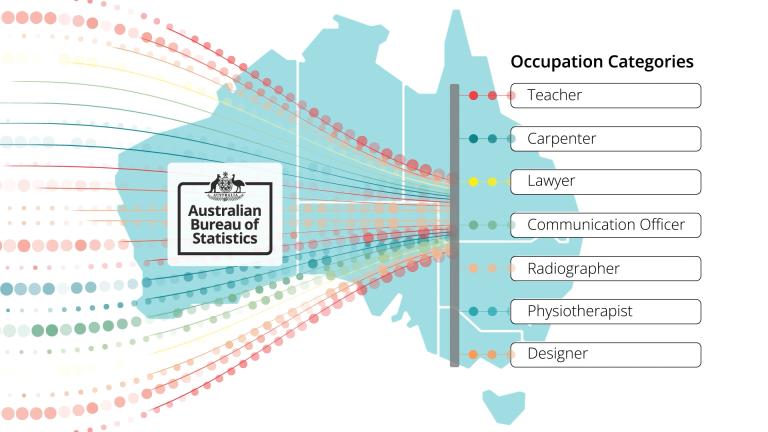Whole of Australian Government Occupation Coding Service
Project summary
Government agencies collect free-text job descriptions from individuals in online forms, surveys, and administrative systems. These responses, such as ‘teacher’, ‘registered nurse’, or ‘brickie’, need to be coded to a standard classification to support statistical analysis, policy development and service delivery. This work is currently resource-intensive and inconsistent across agencies.
The Whole of Australian Government Coding Capability Project provides a solution to this problem by delivering a modern, automated occupation coding service. The service, led by the Australian Bureau of Statistics, helps agencies apply the Occupation Standard Classification for Australia consistently, reducing manual effort while improving data quality.
By aligning practices across government, the service enhances the coherence of Australia’s national data landscape.

Occupation categories in the Whole of Australian Government Occupation Coding Service.
Image: Australian Bureau of Statistics, 2025
How AI contributes to the project
The ABS Whole of Australian Government Occupation Coding Service is an example of applied AI where technology is used to perform tasks that previously required human judgement. The model was developed in-house by the ABS using high-quality, de-identified occupation data.
The AI is trained to recognise and code how Australians describe their jobs. It recognises common job titles, misspellings and informal language. For example, the model understands that ‘brickie’ maps to OSCA occupation 371131 ꟷ Bricklayer.
The service uses machine learning, a branch of AI that finds patterns in data to make predictions. The machine-learning technology standardises and automates the coding of free-text responses, enabling faster, more consistent and scalable processing. This allows skilled staff to shift from undertaking manual data handling to higher-value work such as quality assurance, analysis and insight generation.
The model at the heart of the service is a Hierarchical Support Vector Machine, a type of algorithm well-suited to a hierarchical statistical classification. This model offers a relatively high level of explainability, because it only uses the data it has been trained on. Tokens used to code a response can be identified. This is important for ensuring transparent and accountable decision-making in government.
The service is hosted securely on a cloud platform controlled by the ABS. It is delivered through an application programming interface, allowing it to be integrated into agency systems. Use cases include real-time coding in administrative forms and large-scale batch coding for surveys, research, and statistical outputs.
The service has been developed in line with the Australian Government’s Policy for the responsible use of AI, with strong governance and assurance processes. This enables the model to deliver consistent, high-quality outcomes and supports broader public trust in AI-enabled services.
Outcomes and next steps
By September 2025, 6 government agencies and 8 non-government agencies were using the Occupation Coding Service, following the public beta release in June 2025. These agencies have reported increased auto-coding rates and a reduction in clerical effort.
After using the service, the Queensland Government Statistician’s Office stated:
‘Five minutes to code 100,000 records is pretty exceptional from our perspective, considering it takes people weeks in-house to do that manually.’
The ability to automate coding and integrate the service simplifies the transition to the OSCA. Western Australia’s Department of Training and Workforce Development noted:
‘Our overall confidence in the coding service is high, and now with the switch over to OSCA, we are thinking of more and more uses for it, and suspect it will become a fairly critical product for us.’
Alignment across the public sector increases data comparability as more agencies use the service to code to the OSCA. This helps agencies build a more joined-up view of the national workforce and services.
The ABS intends to use the service to code data for the 2026 Census, expecting to significantly reduce clerical workload and processing time.
Looking ahead, the ABS will continue to monitor and improve model performance, support agencies to use the service, and look to expand its use for coding to other classifications.
Find out more
Australian Bureau of Statistics (n.d.) Whole of Australian Government Occupation Coding Service, ABS website, accessed 29 July 2025.



